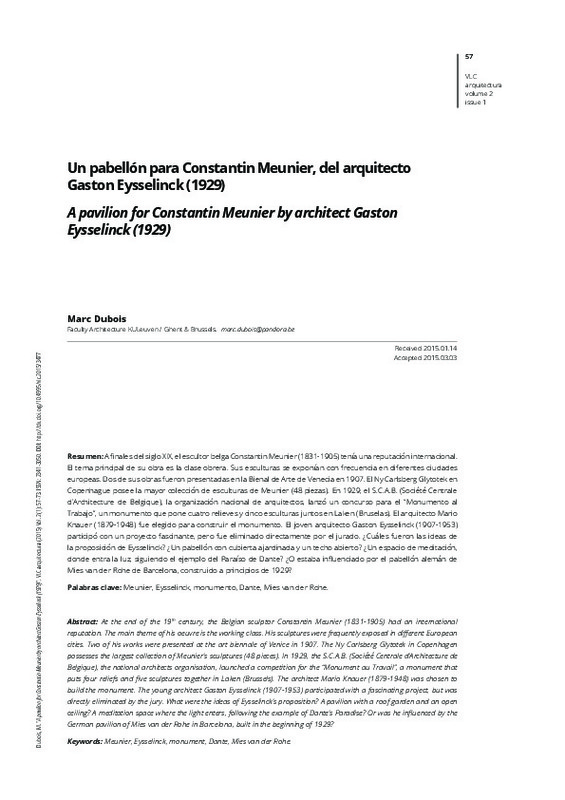JavaScript is disabled for your browser. Some features of this site may not work without it.
Buscar en RiuNet
Listar
Mi cuenta
Estadísticas
Ayuda RiuNet
Admin. UPV
A pavilion for Constantin Meunier by architect Gaston Eysselinck (1929)
Mostrar el registro sencillo del ítem
Ficheros en el ítem
| dc.contributor.author | Dubois, Marc
|
es_ES |
| dc.date.accessioned | 2015-05-06T11:50:08Z | |
| dc.date.available | 2015-05-06T11:50:08Z | |
| dc.date.issued | 2015-04-17 | |
| dc.identifier.issn | 2341-3050 | |
| dc.identifier.uri | http://hdl.handle.net/10251/49778 | |
| dc.description.abstract | [EN] At the end of the 19th century, the Belgian sculptor Constantin Meunier (1831-1905) had an international reputation. The main theme of his oeuvre is the working class. His sculptures were frequently exposed in different European cities. Two of his works were presented at the art biennale of Venice in 1907. The Ny Carlsberg Glytotek in Copenhagen possesses the largest collection of Meunier’s sculptures (48 pieces). In 1929, the S.C.A.B. (Société Centrale d’Architecture de Belgique), the national architects organisation, launched a competition for the "Monument au Travail", a monument that puts four reliefs and five sculptures together in Laken (Brussels). The architect Mario Knauer (1879-1948) was chosen to build the monument. The young architect Gaston Eysselinck (1907-1953) participated with a fascinating project, but was directly eliminated by the jury. What were the ideas of Eysselinck’s proposition? A pavilion with a roof garden and an open ceiling? A meditation space where the light enters, following the example of Dante’s Paradise? Or was he influenced by the German pavilion of Mies van der Rohe in Barcelona, built in the beginning of 1929? | es_ES |
| dc.description.abstract | [ES] A finales del siglo XIX, el escultor belga Constantin Meunier (1831-1905) tenía una reputación internacional. El tema principal de su obra es la clase obrera. Sus esculturas se exponían con frecuencia en diferentes ciudades europeas. Dos de sus obras fueron presentadas en la Bienal de Arte de Venecia en 1907. El Ny Carlsberg Glytotek en Copenhague posee la mayor colección de esculturas de Meunier (48 piezas). En 1929, el S.C.A.B. (Société Centrale d’Architecture de Belgique), la organización nacional de arquitectos, lanzó un concurso para el “Monumento al Trabajo”, un monumento que pone cuatro relieves y cinco esculturas juntos en Laken (Bruselas). El arquitecto Mario Knauer (1879-1948) fue elegido para construir el monumento. El joven arquitecto Gaston Eysselinck (1907-1953) participó con un proyecto fascinante, pero fue eliminado directamente por el jurado. ¿Cuáles fueron las ideas de la proposición de Eysselinck? ¿Un pabellón con cubierta ajardinada y un techo abierto? ¿Un espacio de meditación, donde entra la luz, siguiendo el ejemplo del Paraíso de Dante? ¿O estaba influenciado por el pabellón alemán de Mies van der Rohe de Barcelona, construido a principios de 1929? | es_ES |
| dc.language | Español | es_ES |
| dc.language | Inglés | en_EN |
| dc.publisher | Editorial Universitat Politècnica de València | es_ES |
| dc.relation.ispartof | VLC arquitectura. Research Journal | |
| dc.rights | Reconocimiento - No comercial (by-nc) | es_ES |
| dc.subject | Meunier | es_ES |
| dc.subject | Eysselinck | es_ES |
| dc.subject | Monument | es_ES |
| dc.subject | Dante | es_ES |
| dc.subject | Mies van der Rohe | es_ES |
| dc.subject | Monumento | es_ES |
| dc.title | A pavilion for Constantin Meunier by architect Gaston Eysselinck (1929) | es_ES |
| dc.title.alternative | Un pabellón para Constantin Meunier, del arquitecto Gaston Eysselinck (1929) | es_ES |
| dc.type | Artículo | es_ES |
| dc.date.updated | 2015-05-06T10:49:17Z | |
| dc.identifier.doi | 10.4995/vlc.2015.3477 | |
| dc.rights.accessRights | Abierto | es_ES |
| dc.description.bibliographicCitation | Dubois, M. (2015). A pavilion for Constantin Meunier by architect Gaston Eysselinck (1929). VLC arquitectura. Research Journal. 2(1):57-73. https://doi.org/10.4995/vlc.2015.3477 | es_ES |
| dc.description.accrualMethod | SWORD | es_ES |
| dc.relation.publisherversion | https://doi.org/10.4995/vlc.2015.3477 | es_ES |
| dc.description.upvformatpinicio | 57 | es_ES |
| dc.description.upvformatpfin | 73 | es_ES |
| dc.type.version | info:eu-repo/semantics/publishedVersion | es_ES |
| dc.description.volume | 2 | |
| dc.description.issue | 1 | |
| dc.identifier.eissn | 2341-2747 | |
| dc.description.references | Demanet, M., Knauer, Mario, In: A. Van Loo, ed., Repertorium van de architectuur in België van 1830 tot heden. Antwerp: Mercatorfonds, 2003 | es_ES |
| dc.description.references | DEROUET, Christian, Zervos et Cahiers d'Art, Centre Georges Pompidou, Paris, 2010. | es_ES |
| dc.description.references | Devigne, M., Les Grands Belges: Constantin Meunier, Turnhout: Etablissement Brepols, 1919. | es_ES |
| dc.description.references | Dubois, M., I Giardini's first pavilion / II primo padiglione nei Giardini, In: Architetti della Fiandra, Vlaamse Gemeenschap, Brussels, 1991 | es_ES |
| dc.description.references | DUBOIS, Marc, Een gebouw van Europese klasse - A building of European class, In: Hommage Robert Hoozee, MSK, Gent, 2014. | es_ES |
| dc.description.references | Langui, E., 'Een interview met architect Gaston Eysselinck over functionele architectuur', In: De Vooruit, (14th of November 1937). | es_ES |
| dc.description.references | Thiry, R., Hendrickx, G., Le Monument au Travail de Constantin Meunier, Tekhné, Brussels: 1929. | es_ES |








